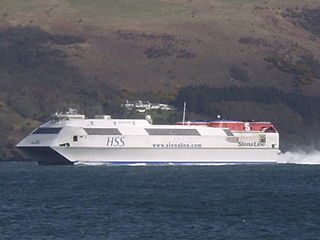 W
WIntermodal freight transport involves the transportation of freight in an intermodal container or vehicle, using multiple modes of transportation, without any handling of the freight itself when changing modes. The method reduces cargo handling, and so improves security, reduces damage and loss, and allows freight to be transported faster. Reduced costs over road trucking is the key benefit for inter-continental use. This may be offset by reduced timings for road transport over shorter distances.
 W
WIntermodal railfreight in Great Britain is a way of transporting containers between ports, inland ports and terminals in England, Scotland and Wales, by using rail to do so. Initially started by British Rail in the 1960s, the use of containers that could be swapped between different modes of transport goes back to the days of the London, Midland & Scottish Railway.
 W
WAccompanied combined transport is a form of intermodal transport, which is the movement of goods in one and the same loading unit or road vehicle, using successively two or more modes of transport without handling the goods themselves in changing modes. More specifically, accompanied combined transport is one of the two types of combined transport, which is intermodal transport where the major part of the journey is by rail, inland waterways or sea, and any initial and/or final legs carried out by road are as short as possible.
 W
WA car shuttle train, or (sometimes) car-carrying train, is a shuttle train used to transport accompanied cars (automobiles), and usually also other types of road vehicles, for a relatively short distance.
 W
WCargobeamer is an intermodal transport system. It involves specially designed pallets which can be carried on a road trailer; the pallets are fitted on top of flatcars but can slide sideways to allow trucks to drive on and off smoothly at intermodal terminals. The first terminal was opened in Leipzig in Germany; trial runs between Leipzig and Lithuania were planned in November 2010. The company advertises several routes:Kaldenkirchen – Domodossola Duisburg – Poznań Calais – Perpignan Calais – Domodossola
 W
WCo-modality is a notion introduced by the European Commission in 2006 in the field of the transport policy to define an approach of the globality of the transport modes and of their combinations.
 W
WContainer chassis, also called intermodal chassis or skeletal trailer, is a specialized semi-trailer, basically a wheeled metal frame, that a shipping container can be mounted onto for road transport. Chassis are used by truckers to deliver containers between ports, railyards, container depots, and shipper facilities. This type of trucking is sometimes called drayage.
 W
WContainer on barge is a form of intermodal freight transport where containers are stacked on a barge and towed to a destination on an inland waterway.
 W
WContship Italia Group is an Italian container terminal, intermodal & logistics operator.
 W
WThe Dry Port of Madrid, also known as the Dry Port of Coslada, is a logistics platform for the distribution of goods located in the Spanish municipality of Coslada, near Madrid.
 W
WEurotunnel Le Shuttle is a railway shuttle service between Coquelles in Pas-de-Calais, France and Cheriton in Kent, United Kingdom. It conveys road vehicles and passengers by rail through the Channel Tunnel. Freight vehicles are carried in separate shuttle trains hauled by the same locomotives and a passenger carriage, known as the Club Car.
 W
WAn inland port is a port on an inland waterway, such as a river, lake, or canal, which may or may not be connected to the sea. The term "inland port" is also used to refer to a dry port.
 W
WKombiverkehr is an intermodal transport business based in Frankfurt, Germany. It is an intermodal operator in Europe, operating a fleet of block trains linking 30 countries. In May 2010, Kombiverkehr launched a service between Antwerp and Duisburg; services to Turkey have also been launched.
 W
WThe Lohr Railway System or Modalohr System uses special railway wagons of a type known as piggyback wagons, to carry standard road semi-trailers on the European rail network. They are currently used on the AFF route from France to Italy and Luxembourg to the French border with Spain and vice versa. There are plans to expand this service. They have also been approved for the Channel Tunnel. This articulated railway wagon consists of two low-floor decks, resting on a single Y25 jacobs bogie in the middle and on two Y33 bogies on the extreme ends. Using standard bogies resulted in lower maintenance costs compared with the similar rolling highway concept. The deck between the bogies (trucks) pivots (swings) 30°, allowing the trailers to be loaded from the sides. The cars are built by Lohr Industrie.
 W
WPiggyback transportation refers to the transportation of goods where one transportation unit is carried on the back of something else. It is a specialised form of intermodal transportation and combined transport.
 W
WIn rail transportation, a rolling highway, or rolling road is a form of combined transport involving the conveying of road trucks by rail, referred to as Ro-La trains. The concept is a form of piggyback transportation.
 W
WTrailer on flatcar, also known as TOFC or piggyback, is the practice of carrying semi-trailers on railroad flatcars. TOFC allows for shippers to move truckloads long distances more cheaply than can be done by having each trailer towed by a truck, since one train can carry more than 100 trailers at once. The trailers will be moved by truck from their origin to an intermodal facility, where they will then be loaded onto a train, typically by a rubber tyred gantry crane, for the bulk of their journey. Alternatively, trailers may be driven onto the flatcars via ramps by a terminal tractor. Near the destination, the trailers are unloaded at another facility and brought to their final destination by truck.